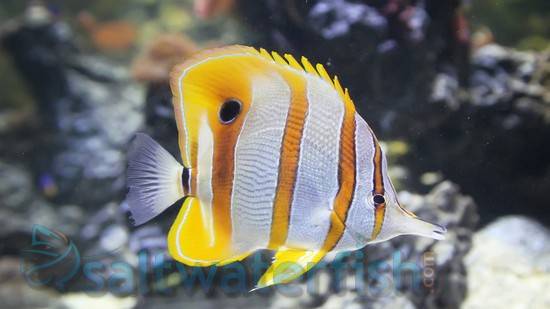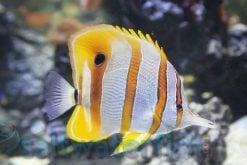Quick Stats:
- Care Level: Moderate
- Temperament: Peaceful
- Diet: Carnivore
- Reef Safe: With Caution
- Minimum Tank Size: 120 gallons
- Max Size: Up to 8 inches
- Water Parameters: pH 8.1-8.4, Salinity 1.020-1.025, Temperature 72-78°F
Comprehensive Guide: Copperband Butterfly (Chelmon rostratus)
The Copperband Butterfly, also known as Chelmon rostratus, is a beautiful and popular fish species in saltwater aquariums. In this comprehensive guide, we will cover various aspects of keeping and caring for the Copperband Butterfly.
Habitat
The Copperband Butterfly is native to the Indo-Pacific region, including the Red Sea, Indian Ocean, and the western Pacific Ocean. It inhabits coral reefs and lagoons, often found near areas with rich coral growth.
Reef Safe
The Copperband Butterfly is generally considered reef-safe with caution. While it is not known to harm corals, it may nip at certain types of invertebrates, such as tube worms and feather dusters. It is important to monitor their behavior closely if kept in a reef aquarium.
Size
The Copperband Butterfly can grow up to 8 inches long, making it a medium-sized fish for a saltwater aquarium.
Temperament
The Copperband Butterfly is known for its peaceful temperament. It usually gets along well with other non-aggressive fish species in the aquarium.
Sexual Dimorphism
There are no distinct visual differences between male and female Copperband Butterflies.
Lifespan
The average lifespan of a Copperband Butterfly in captivity is around 5-7 years. With proper care and a suitable environment, they can live even longer.
Diet in Aquariums
Copperband Butterflies are carnivores that feed on small invertebrates in the wild, such as worms, crustaceans, and small mollusks. In aquariums, they should be offered a varied diet consisting of high-quality frozen or live foods, such as brine shrimp, mysis shrimp, and finely chopped seafood. Providing them with multiple feedings throughout the day is important to ensure they receive enough nutrition.
Aquascaping Recommendations
When setting up the aquarium for a Copperband Butterfly, it is essential to create a well-established reef environment with plenty of hiding places and live rock. The addition of corals and other invertebrates should be done cautiously, considering their potential interaction with the Copperband Butterfly.
Captive Bred Availability
The Copperband Butterfly is rarely available as captive-bred. Most specimens in the aquarium trade are wild-caught. It is important to source them from reputable suppliers who practice sustainable collection methods.
Compatibility with Other Fish, Invertebrates, or Corals
The Copperband Butterfly can generally coexist in a saltwater aquarium with other peaceful fish species. However, caution should be exercised when introducing them to tanks with delicate invertebrates or corals. Here are five specific tankmates that can be good choices:
- Clownfish: Clownfish are known for their peaceful nature and can form a symbiotic relationship with anemones, adding visual interest to the aquarium.
- Gobies: Gobies are small, peaceful fish that can help control algae growth in the aquarium.
- Firefish: Firefish are colorful and peaceful fish that can add movement and beauty to the tank.
- Blennies: Blennies are known for their unique personalities and can be great tankmates for Copperband Butterflies.
- Anthias: Anthias are schooling fish that add vibrant colors and activity to the aquarium.
When introducing any new fish species, monitoring their behavior and ensuring they are compatible with existing tank inhabitants is important.
Other Common Names
The Copperband Butterfly is also known by the following common names:
- Beaked Coralfish
- Longnose Butterflyfish
Why Buy from Reefs4Less.com
Reefs4Less.com is a reputable online retailer specializing in saltwater aquarium supplies. They offer a wide range of high-quality products, including fish, corals, and equipment. Their commitment to customer satisfaction, competitive pricing, and sustainable sourcing make them a trusted choice for saltwater aquarium enthusiasts.
Popular Questions and Answers
Q: Can Copperband Butterflies be kept in a reef aquarium with corals?
A: While Copperband Butterflies are considered reef-safe, they may nip at certain invertebrates, including some corals. It is important to monitor their behavior closely and choose tankmates carefully.
Q: How often should I feed my Copperband Butterfly?
A: Copperband Butterflies should be fed multiple times daily with a varied diet of high-quality frozen or live foods. Regular feedings are essential to meet their nutritional needs.
Q: Can Copperband Butterflies be kept in pairs?
A: Copperband Butterflies are typically solitary fish and may not tolerate conspecifics in the same tank. It is best to keep them individually unless you have a huge aquarium with plenty of hiding places.
Q: How can I encourage my Copperband Butterfly to eat in captivity?
A: Some Copperband Butterflies may be initially picky eaters. Offering live or frozen foods that resemble their natural prey can help stimulate their appetite. Patience and persistence are key in ensuring they receive proper nutrition.
Q: Can Copperband Butterflies be kept with aggressive fish species?
A: It is generally not recommended to keep Copperband Butterflies with aggressive fish species, as they are peaceful and may become targets of aggression. It is best to choose tankmates with similar temperaments.
| Size | 2.25 – 3.5 inches |
|---|



Reviews
There are no reviews yet.